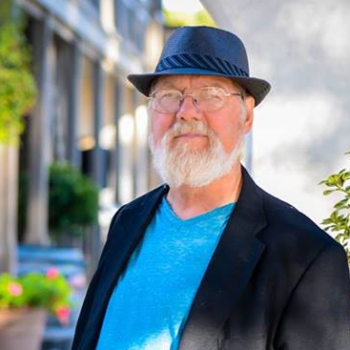Rico Gagliano: Do you remember the first ghost story you heard?
Richard Senate: Oh yes, I remember the first. My mother was a great storyteller, and she had one that really creeped me out called “My Body Floats.” Yeah, it was a great story. It was about a lady whose sister had vanished at sea and she kept seeing her in a dream, all of her skin removed, saying, “My body floats.” She accosted her sister’s husband, who was a doctor. And she says, “I keep having the dream.” And he said, “You’re crazy, get out of here.” And then finally she went to his place of employment, and in the dissection room were large tanks of formaldehyde filled with cadavers floating with no skin on their bodies, and she recognized one of the floating bodies as her sister. Her husband had, of course, killed her and faked her death and put her in with the other cadavers to conceal his crime.
Rico Gagliano: Oh man. Nighty-night, young Richard Senate.
Richard Senate: Yeah, I’m like seven or eight. So maybe that’s why I take to ghost stories and storytelling so well.
Rico Gagliano: I wondered the opposite. You know, I have a very low threshold for getting creeped out, and I have always kind of avoided overtly scary things. What do you think it is that made you learn even more about ghosts and ghost stories? What pulls you towards the darkness?
Richard Senate: One of the things that really pulled me toward the dark side is when I actually saw a ghost, and it was not anything I expected or wanted or tried to see. I was doing archaeology, because that is what my training and background is, Spanish Colonial.
We were at one of the old Spanish missions. Late one night, I was walking through the courtyard, and I saw a bit of a light, looked at, and finally saw it was a monk with a hood.So I thought “Oh, one of the brothers is up, I’ll go talk to him.” AndI walked towards him, I got about ten feet away, and bam, he disappeared. He just vanished.And I went “Agh, what did I see?” My first reaction was that he fell into a hole, and I looked and there’s no hole.
The next morning I met with the monks who lived there and I said, “Any ghost stories about this mission?” And they stopped their eating and they looked at me and they said there had been a member of their order who was a good guy, like a living saint. They loved him. And every night at 12:30 he would light a candle, leave his room, and go into the church for an extra hour of prayer above and beyond the call of prayers that they normally have.
Rico Gagliano: He was throwing off the grading curve of monks.
Richard Senate: Yeah, anyway, he died because he was an old man, 82 or something like that. He dies, and they would see his ghost doing that ritual.
Rico Gagliano: Oh man.
Richard Senate: As they are telling me the story, the hair is rising on my neck because that is what I saw.
Rico Gagliano: Oh my gosh.
Richard Senate: I saw Brother Joseph. And people ask me how long was it before you got interested in ghosts? I say about, oh, 30 seconds. So I’ve been looking for ghosts, asking about ghosts, recording ghosts, up and down the state of California and Nevada and Arizona, even Hawaii.
Rico Gagliano: Actually, I want to think kind of big-picture here for a minute. What do you find common to ghost stories everywhere, in all of those states? Are there themes that are similar across?
Richard Senate: Oh yeah, in fact, if you go back in time, the earliest records we have of human beings on planet earth are ghost stories. The first thing people write about are prayers to their gods. The second thing, taxes and records for their rulers. And the third thing, ghosts.
Rico Gagliano: After the thing that really freaked them out, taxes.
Richard Senate:
Those old ghost stories 5,000 years ago are almost identical to what we record today. Many of them are very emotion-laden love stories, in other words a man loves a woman so much that death cannot separate them. Or, morality tales, people do bad things and then they’re punished, a ghost comes back and haunts them. Stories of justice.You know a long time ago people believed that. If you believe that if you murdered somebody, even if it was a perfect crime, their ghost would come for you. That might keep you from doing some kind of crime.
Rico Gagliano: In the absence of maybe excellent judicial systems, ghost stories keep folks in line. Interesting. I mean it’s also interesting that all of those themes kind of remind me of almost classic Greek tragedy themes, you know, lovers or revenge.
Richard Senate: Oh, very much. One of the greatest ghost stories of all is “Hamlet.” In fact, if we took ghosts out of western civilization, there would be a gigantic hole.
Rico Gagliano: There would be nothing left.
Richard Senate: Well, there’d be something left, but not much.
Rico Gagliano: Just sitcoms, pretty much. All right, well we’re here in California. That’s your beat, as it were. I don’t often think of California as rife with darkness, but of course this is the land of the Manson family and the Zodiac murders. How do we stack up against other states as far as ghost story culture?
Richard Senate: Oh, we have a lot. There are other states that are more haunted, I will tip my hat to them, especially Louisiana.
Rico Gagliano: Well of course, with the cemetery tours and all that.
Richard Senate: New Orleans is like capital for Ghost City, all of the southern states have ghosts galore, but California is no piker.
I found that we have different cultures. One culture being dominated by another and outrages that happen in that domination, that it leaves scars – ghosts, if you will. And so we have the Native Americans dominated by the Spanish, then the Spanish dominated by the Yankees, and then other groups coming in. So all of these layers have left things behind. So there’s no shortage of ghosts here in California.
Rico Gagliano: I see. And I understand you actually have an example for us of a California ghost story where it sounds like the offending dominating culture is actually youth culture. What is this story called?
Richard Senate: “Char-Man.”
Rico Gagliano: “Char-Man.” That doesn’t sound happy. And while you tell this, I’m just going to leave the studio and sit with my fingers in my ears until it’s over if that’s okay.
Richard Senate: Char-Man is an old yarn. Now in a little valley off the Ventura Coast called Ojai, an old Indian valley. The name Ojai is in the Indian language – it means moon. Well, it’s now a very peaceful, calm town. There’s nothing for teenagers to do. And so back in the 1950’s, it became all the rage for young people to get old cars, build them into hot rods, listen to Wolfman Jack on the radio, drink beer if they could get it – Miller High Life or Brew 102 – and listen to music and dance and party away the evening.
On Creek Road, there was an old farmer who was an alcoholic. Well, wouldn’t you know it, the kids took to stopping at his farm, parking on his property, playing their loud rock and roll music. Well that farmer, he heard them out there. So he went to the closet, brought out the 12-gauge shotgun, and he fired one barrel into the air. Boom! Well the kids, they jumped in their cars and they drove away.
They went about two miles down the road and they got to thinking, “Why that old fool. He could have accidentally shot someone. Our lives were in danger. Someone needs to teach that old man a lesson.”
One of the kids, drunker than the others, got in his hot rod and drove back to the farm. Then he went into the trunk where he had a can of gas, and there was an old tool shed that hadn’t been painted in 30 years, flaking paint, and he put the gas on that dry wood that soaked it up like a sponge, and it set it on fire. “That’ll teach that old fool.”
He got in his car and he drove away. Finally a little wind came up, and embers from the fire went across to the main house. And inside the old farmer was drunk and passed out. He didn’t wake up until a burning ash fell upon his cheek. He tried to escape, but was burned to death in the conflagration.
But that’s not the end of the story. Cut to the future, 2004. I talked to a kid, a big kid. He was on the football team as a matter of fact, he’s a letterman. He was driving Creek Road at night after going to a party, and he lives right off Creek Road on Apache. All of a sudden his car, it was an older car, just died and stopped working.
So he put on his letterman jacket and was walking along, and he hears footsteps behind him.
He looks back. Nothing there. So he starts to walk a little faster. Behind him the footsteps. They’re going faster too. Now he starts to run. And then out of the darkness of the trees, a figure leaps out.This horribly burnt man grabbed him by the collar of his coat and was more powerful than he was, and he pulled, and he couldn’t escape. Finally he pulled his sleeves out of the jacket, he left it, and he took off running. The next morning he told his father about his car breaking down and how he had lost his jacket.
They went back to the car, he put his key and turned it. It started right up. He drove it home. But those who have driven Creek Road late at night still see the ghost of Char-Man. He hates teenagers. They say he now wears a letterman jacket.


